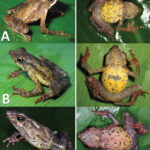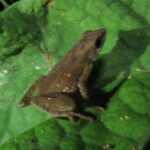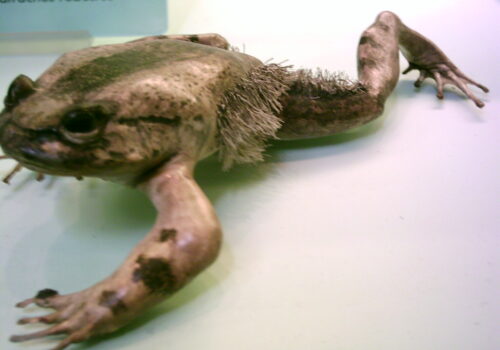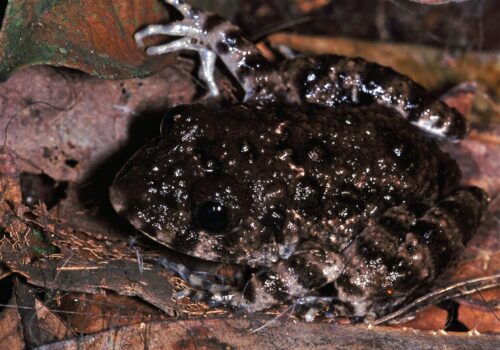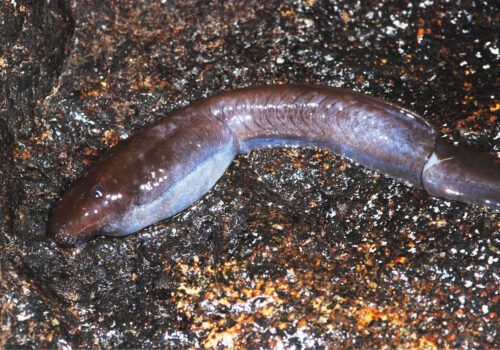- Leptopelis mtoewaate: Secrets of Tanzania's Enigmatic Forest Frog
- Taxonomy and Classification: Placing Leptopelis mtoewaate on the Tree of Life
- The Natural Habitat: Enchanting Forest Streams and Moist Highland Canopies
- Physical Characteristics: Mastering Artful Camouflage in a World of Greens and Browns
- Behavior and Life Cycle: Resonating Calls and Secretive Nocturnal Rhythms
- The Ecological Role: Silent Sentinels of the Forest's Health
- Threats and Conservation Status: Fragile Futures
- Conclusion: Celebrating the Hidden Wonders of Leptopelis mtoewaate
Leptopelis mtoewaate: Secrets of Tanzania’s Enigmatic Forest Frog#
In the lush, vibrant forests of Tanzania, amid towering canopies dappled by sunlight and hidden beneath the gentle whispers of leaves, dwells a captivating presence: the rare and mysterious Mto Wa Ate tree frog, scientifically known as Leptopelis mtoewaate. Named after the type locality at Mto wa Ate, a stream nestled within Tanzania’s Eastern Arc Mountains, this elusive species enchants biologists and nature enthusiasts alike with its uniquely secretive lifestyle and striking features. Remarkably elusive, little known outside dedicated herpetological circles, this remarkable amphibian holds secrets not only to biodiversity but acts as a sensitive indicator of Tanzania’s ecological health and forest vitality.
The subtle rhythms of Leptopelis mtoewaate’s chorus echo faintly within forest nights, emerging eloquently as gentle whistles and resonant trills that animate moonlit canopies. Despite its profound ecological significance, this tiny tree-dweller often goes unnoticed due to its cryptic coloration and nocturnal silent creeping along forest branches. Yet the story behind this remarkable frog extends beyond its evocative calls and striking greens and tans; it provides biologists with precious indications about habitat health, climate dynamics, and the urgent pressures of environmental change. Today, we journey deep into the hidden world of Leptopelis mtoewaate, unraveling the fascinating blend of adaptive biology, ecological connections, and conservation challenges that shape the existence of this remarkable frog.
Taxonomy and Classification: Placing Leptopelis mtoewaate on the Tree of Life#
Belonging within the large and diverse family Arthroleptidae, renowned for its fascinating diversity of tree frogs and stream dwellers scattered across the African continent, Leptopelis mtoewaate occupies a unique niche in this biological lineage. First scientifically described in recent years, its classification as a species within the genus Leptopelis has sparked interest due to its unique morphological traits and localized distribution. This genus, commonly known as forest tree frogs, comprises numerous species scattered broadly across Sub-Saharan Africa, often celebrated for their brilliantly colored eyes and remarkable calls echoing through forest canopies.
Within this diverse genus, Leptopelis mtoewaate stands distinct due to subtle morphological features discovered carefully through meticulous analysis. Its closest relatives—other Leptopelis species occupying adjacent geographic ranges—share similar ecologies but differ notably in call structure, coloration patterns, and micro-habitat preferences. Understanding this taxonomy not only enriches our appreciation for Tanzania’s endemic wildlife but also deepens insights into evolutionary processes, biogeography, and historical environmental shifts shaping life in East Africa’s famed biodiversity hotspots.
The Natural Habitat: Enchanting Forest Streams and Moist Highland Canopies#
The story of Leptopelis mtoewaate begins and unfolds in Tanzania’s iconic Eastern Arc Mountains—a chain of ancient mountain ranges recognized globally for their rich biodiversity and high degree of endemism. Known as “Africa’s Galápagos,” this region harbors pockets of ancient, wet forests cloaked in mist, threaded by pristine mountain streams, and blanketed with dense moss and ferns carpeting thick roots and rocky banks. It is amid these habitats that our amphibious protagonist thrives.
Specifically favoring montane moist forests associated with flowing freshwater streams and cascades, these frogs occupy micro-habitats characterized by high humidity, gentle shading from towering indigenous trees, and dense, lush understory vegetation. The forest ecosystem provides ample hiding spots among broad leaves and overhanging branches, where this agile tree frog blends adeptly into moss-laden branches or vibrant foliage, rendering it nearly invisible to predators and curious human eyes alike.
Biodiverse, humid, and pristine—these forests provide crucial microclimates and abundant insect prey resources essential to the frog’s daily survival. Modified and degraded habitats fail to support the intricately woven ecological balance required, underscoring the frog’s exceptional sensitivity to environmental changes. Perfectly adapted to their hidden habitat, Leptopelis mtoewaate embodies the intricate relationships among species, played out quietly beneath verdant skies.
Physical Characteristics: Mastering Artful Camouflage in a World of Greens and Browns#
At first glance, the modest yet fascinating appearance of Leptopelis mtoewaate perfectly embodies stealth and subtlety. Measuring around 4–6 centimeters from snout to vent when mature, these frogs are compact, agile climbers endowed with muscular limbs and proportionate toe pads, highly specialized features developed for arboreal navigation. Climbing efficiently over leaves, bark, and mossy substrates, their adaptations ensure they navigate seamlessly through their complex arboreal micro-habitats.
Their coloration varies gently across shades of fresh leafy greens, browns, and subtle olive hues, their skin decorated by subtly mottled patterns and folds mimicking moss growth or leaf textures. This artistic mastery allows the frog extraordinary camouflage abilities essential for avoiding predation. When threatened or approached, individuals typically press their bodies flat against branches, closing their vividly patterned eyes, and blending seamlessly into the vegetation.
The defining beauty of this species perhaps lies in its large, expressive eyes—golden to copper-colored irises shimmering softly in torch-lit nighttime searches, gleaming gently against the mossy backdrop of their habitat. These sparkling eyes also speak volumes about their nocturnal existence, capable of acute vision under dim moonlight necessary for hunting small invertebrate prey during nights cloaked in absolute darkness.
Behavior and Life Cycle: Resonating Calls and Secretive Nocturnal Rhythms#
Leptopelis mtoewaate are almost strictly nocturnal, emerging from protective daytime retreats at dusk to orchestrate a rich tapestry of vocalizations permeating the darkness. Male frogs initiate melodious, resonant calls aiming to attract receptive females. Calling is highly seasonal, aligned with the onset of rains when breeding pools and rich moisture optimally support tadpole development. As seasonal rains replenish mountain streams, adult frogs descend from the canopy to stream banks and temporary pools, engaging in elaborate vocal duels, amplified by natural acoustics of the forest’s wet landscape.
Reproductive activity includes egg deposition on vegetation overhanging or close to freshwater pools, carefully chosen to facilitate tadpole survival and development. Eggs hatch into tadpoles that subsequently plunge into aquatic habitats, completing their early stages submerged beneath shaded, sheltered water reflections. Dark-colored and well-camouflaged larvae quickly adapt, feeding on aquatic algae, detritus, and microorganisms naturally prolific within these pristine forest streams.
The Ecological Role: Silent Sentinels of the Forest’s Health#
Life in the forest is a carefully structured balance—and the frogs act as essential ecological threads weaving nutrient cycling and energy flow. As proficient predators, they regulate pest insect populations, preventing potential outbreaks detrimental to forest vegetation. They also serve as crucial prey for reptiles, birds, and small mammals, sustaining predator species integral to this complex food web.
Moreover, amphibians like Leptopelis mtoewaate serve as valuable bioindicators, reacting sensitively to subtle environmental changes such as pollution, climate shifts, or habitat degradation. Their thriving or declining populations quickly alert biologists to broader environmental issues warranting prompt ecological interventions.
Threats and Conservation Status: Fragile Futures#
Unfortunately, Leptopelis mtoewaate faces growing threats from habitat loss, deforestation, agriculture expansion, and climate-driven ecosystem shifts. Although not extensively studied yet regarding their conservation status by the International Union for Conservation of Nature (IUCN)—due primarily to recent discoveries and sparse ecological surveys—their localized distribution, specialized habitat, and sensitivity clearly classify them as vulnerable to habitat disruptions likely impacting other amphibian species in this biodiversity-rich region.
Conservation efforts urgently require habitat preservation within Tanzania’s threatened Eastern Arc forest reserves. Strengthening protected status, community engagement, habitat restoration initiatives, and continuous monitoring of populations stand as actionable strategies necessary to safeguard this charismatic amphibian and its forest home.
Conclusion: Celebrating the Hidden Wonders of Leptopelis mtoewaate#
The tale of Leptopelis mtoewaate is far more than an exploration of a uniquely adapted amphibian—it highlights the fragile interconnectivity binding wildlife, ecosystems, and humanity. Protecting this delicate species, a whispering presence in Tanzania’s enchanting forests, calls upon conservation enthusiasts worldwide to act thoughtfully and decisively. By safeguarding its habitats, we preserve not merely an amphibian species, but an intricate story of evolutionary adaptation, ecological interconnection, and the awe-inspiring beauty of the natural world itself.


